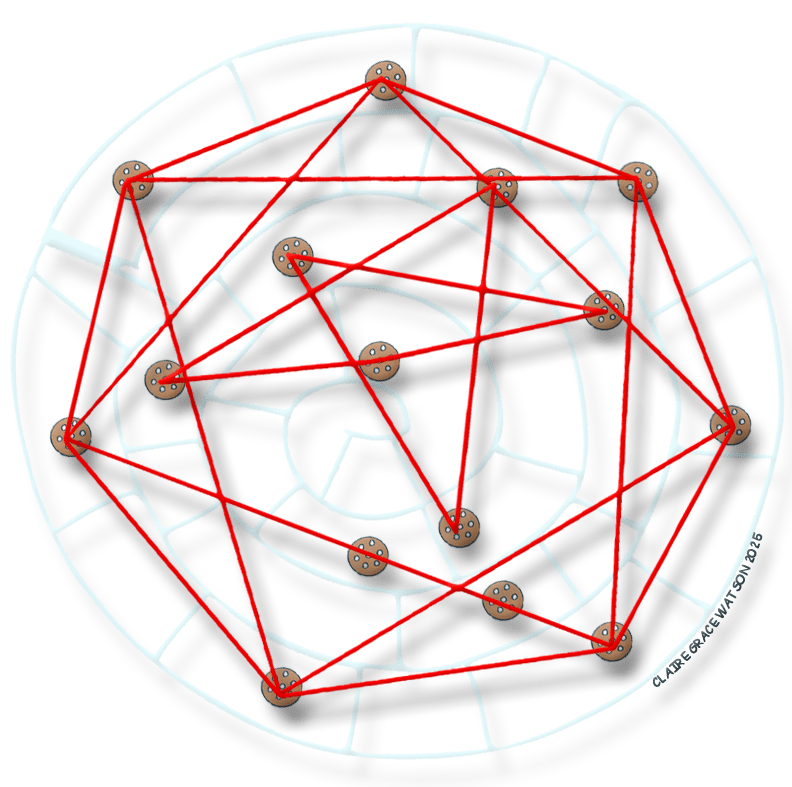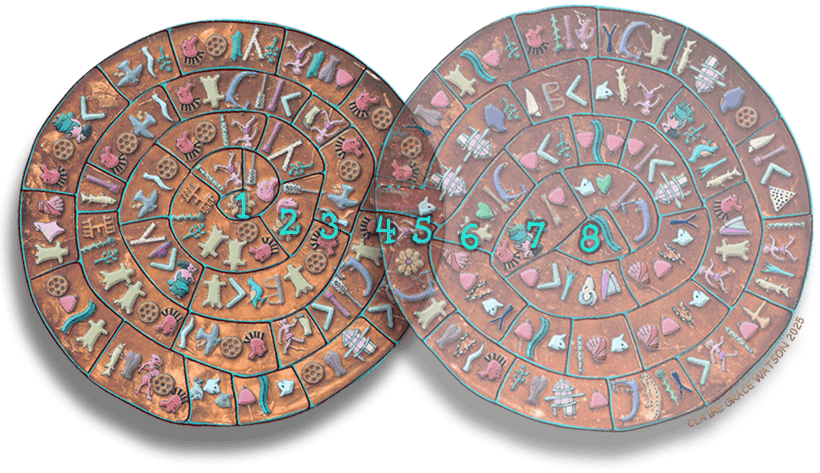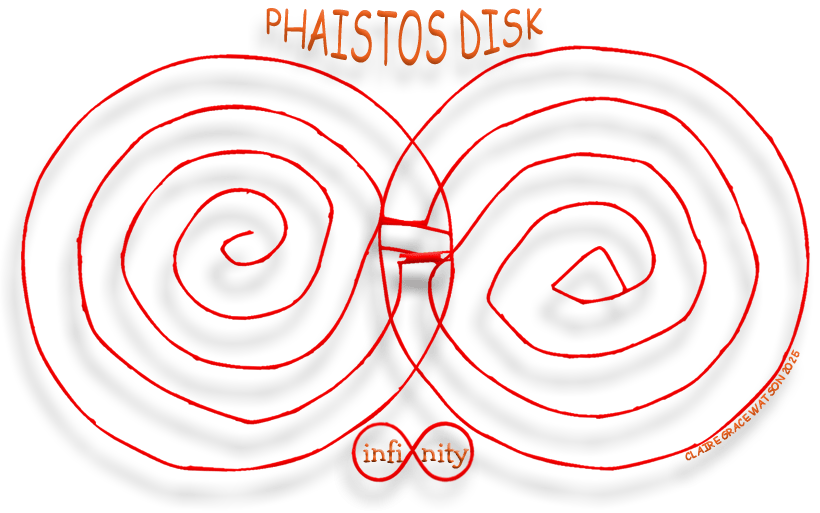
This is a Bronze Age puzzle and the most famous "undeciphered" artifact in archaeology. Overlap the two sides to solve the puzzle and reveal the maze. This solution results in the display of another puzzle. If the Phaistos Disk is the Disk of the World, why is it shaped like a figure 8?
...in those days [of ancient Egypt] of initiate kings and rulers and sages who occupied themselves with the Sacred Science, when the clear Aether spake face to face with them without disguise, or holding back aught, in answer to their deep scrutiny of holy things.
Bronze Age geometry theology involving Containment of Geometrical Arrangements may have passed from Minoan Crete into modern mysticism as the Emerald Table of Hermes Trismegistus, which could begin to explain why the known universe would be shaped as a figure 8. This geometry theology and number philosophy eventually became known as Sacred Geometry.




The pentagram-heptagram-heptagon geometry on the Phaistos Disk demonstrates a knowledge of the Emerald Table, or whatever they called it then. The Star Sirius configuration is created by connecting with lines the 15 Shield pictographs containing a hexagram in the center. This accounts for 5 (pentagram), 6 (hexagram), and 7 (heptagram, heptagon). Next comes 8, which is revealed by overlapping the connecting, matching line segments on the two spirals of the Disk to create a figure 8. Where before 10 spirals were visible, 5 each side, now they have become 8 with the overlap, the number of the Ogdoad where reside the Egyptian gods Isis and Osiris and now proved to exist by the mathematics on the Disk.

This indicates the creator of the Disk might have had a theory that the geometry force holding the universe together is complex and much more advanced than that which binds the stars and planets together. I think the Phaistos Disk also proves the existence of Minoan astronomers, who speculated (see the Phaistos Disk Heliocentric Solar System on Page 4) that Earth is a planet and that the planets revolve around the sun "on the circumference of a circle," (Archimedes of Syracuse) and remain in their orbit because they are connected to each other, not by the force of gravity, of which they knew nothing, but by the force of geometry, of which, apparently, they were masters.
 This is perhaps the original idea regarding the layered architecture of the celestial realms involving three important layers, as elucated 2,000 years later by Early Common Era Gnosticism. They are the Hebdomad (7), the Ogdoad (8), and the Ennead (9). On the Phaistos Disk is the theory regarding the layered architecture of the Ogdoad, the eighth sphere or aeon, and its continuum concept. Perhaps this is where our symbol for infinity originally comes from. Turned on its side it becomes the modern symbol for infinity or endlessness. The Ogdoad is marked by the brightest star in the sky, Sirius (brightest because of its proximity to our solar system). In Minoan mythology Sirius is the Minoan creation goddess Rhea (Chaos). In the invisible dimension where the lives, both above and on the Phaistos Disk, she is center the universe/Disk and surrounded by the planets revolving around her.
This is perhaps the original idea regarding the layered architecture of the celestial realms involving three important layers, as elucated 2,000 years later by Early Common Era Gnosticism. They are the Hebdomad (7), the Ogdoad (8), and the Ennead (9). On the Phaistos Disk is the theory regarding the layered architecture of the Ogdoad, the eighth sphere or aeon, and its continuum concept. Perhaps this is where our symbol for infinity originally comes from. Turned on its side it becomes the modern symbol for infinity or endlessness. The Ogdoad is marked by the brightest star in the sky, Sirius (brightest because of its proximity to our solar system). In Minoan mythology Sirius is the Minoan creation goddess Rhea (Chaos). In the invisible dimension where the lives, both above and on the Phaistos Disk, she is center the universe/Disk and surrounded by the planets revolving around her.

The Phaistos Disk was excavated in the ruins of Phaistos, Crete, a Mediterranean Bronze Age city, in 1908. It is the most famous maze puzzle in the world except for one - the Maze of Daedalus. It is also the only disk of its kind to survive. I believe the Phaistos Disk is a pattern recognition puzzle from the Bronze Age, in the sense that if the patterns are not recognized the artifact can't be comprehended. The patterns involve plane geometry, calendar applications, and a pictograph language description of Minoan Crete.
The creator of the maze puzzle made a two-sided clay disk, rather than two disks with one side each of impressions. Putting impressions on both sides of one disk kept the puzzle intact for 3,600 years. The pictographs on the disk were etched into it. 48 unique pictographs are scattered across the disk for a total of 240 impressions. 37 pictographs were repeated, 11 were not.
The etched pictographs made it possible for the creator of the maze puzzle to present the disk puzzle for solution, and then when the solution was impossible to find, the creator could have stamped each side of the disk into wet sand in a certain pattern so that the solution was suddenly easy to see. It must have been amazing for the people who saw it. It amazes me endlessly. And that also is a good way to describe the disk - an endless figure 8 maze.
But the perishable nature of the materials on which picture-writing, having for most part only a temporary value, was usually wrought has been fatal to the survival of primitive European pictographs on any large scale. If we had before us the articles of bark and hide and wood of early man in this quarter of the globe or could still see the tattoo marks on his skin we should have a very different idea of the part once played by picture-writing on European soil. As it is, it is 'right' that the imagination should supply the deficiency of existing evidence. (Cretan Pictographs and Prae-Phonecian Script Arthur J. Evans, M.A., F.S.A.)
Did the world-famous Minoan inventor Daedalus create this disk? People might have come from miles around to see it. If only we could look back in time, back through the stars, we might see the civilization of Minoan Crete and the people arriving at Knossos Palace during the festival of Dionysus. Perhaps the disk was as famous then as it is now. In fact, there is a good chance it is the lost Maze of Daedalus, created by the famous genius himself. People would marvel at it as Daedalus showed them this maze puzzle, flipping it from side to side so they could see it, challenging them to find the solution to the maze. If they solved it they perhaps would win a prize. If not, they might pay to see the solution, which was easy enough to display.
Daedalus would stamp one side into the sand and then stamp the other side beside it, overlapping the line segments as shown above. Then he would trace with his finger the spirals around and around to show the uninterrupted movement from the center of one spiral to the center of another. The reenactment of the creation of the disk and the people who came to see it is included in The Shadow Breakers, a work of fiction by this author that incorporates 22 images of the Phaistos Disk.
 I think the Phaistos Disk is still considered to be undeciphered because scholars approach it from the standpoint of what they want it to be rather than allowing it to be whatever it is, which was my approach. As I had no paycheck on the line as regards my thinking about it, I could give it the latitude it deserves. But academia, and particularly linguists, want it to be like hieroglyphics but, as Sir Arthur Evans said nearly 100 years ago, etched into the clay are pictographs or picture writing. Although Evans was not aware of it, nor anyone else until the presentation of my solution, this method of pictograph inscription creates a pattern recognition puzzle that can be solved. Displayed on this web site is my solution to this ingenious puzzle.
I think the Phaistos Disk is still considered to be undeciphered because scholars approach it from the standpoint of what they want it to be rather than allowing it to be whatever it is, which was my approach. As I had no paycheck on the line as regards my thinking about it, I could give it the latitude it deserves. But academia, and particularly linguists, want it to be like hieroglyphics but, as Sir Arthur Evans said nearly 100 years ago, etched into the clay are pictographs or picture writing. Although Evans was not aware of it, nor anyone else until the presentation of my solution, this method of pictograph inscription creates a pattern recognition puzzle that can be solved. Displayed on this web site is my solution to this ingenious puzzle.
The two sides placed side-by-side this way show how to position the bottom disk (side 2) onto the top disk (side 1) at the matching vertical line segments to create the Minoan wave spiral. You can't solve it by leaving it intact as a two-sided disk unless your imagination is pretty good, so apparently the puzzle, during its day, was created by pressing the disk into the sand, probably wet sand.
Although most photographs of the disk create the appearance of raised pictographs, they are instead carved into the disk, so that pressing the disk into wet sand would create raised pictographs to present the puzzle, and then lines could be drawn in the sand to reveal the hidden, large pictographs. I believe it was such a famous puzzle that it became known thoughout time as the Maze of Daedalus.
The same development from the simple pictographic to the hieroglyphic or quasi-alphabetic stage might naturally have been expected to have taken place in more than one European area had it not been cut short by the invasion of the fully equipped Phoenician system of writing...Even as it is however, it must be allowed that there are strong a priori reasons for believing that in the Greek lands where civilization put forth its earliest blossoms on European soil, some such parallel evolution in the art of writing must have been in the course of working itself out." (Cretan Pictographs and Prae-Phonecian Script Arthur J. Evans, M.A., F.S.A.)
Is the Phaistos Disk actually the legendary Maze of Daedalus, and we just don't realize it?
The Phaistos Disk, located but not explained, is probably the most famous maze in the world
except for the Maze of Daedalus, explained but not located. In the Phaistos Disk we have the artifact but not the narrative. In the
Maze of Daedalus we have the narrative but not the artifact.
It seems possible to me that something found as an artifact today could be so remarkable when it was created that an entire mythology could
grow up around it and endure for thousands of years. The mythology could have passed down to us while the artifact was lost.
If the artifact was later found, then it might be possible to connect it to the ancient legend surrounding it. And as it involves the Minoan inventor Daedalus,
the world's greatest inventor, then it could be possible the Minoan Phaistos Disk was his most famous invention - the Maze of Daedalus - from which his legend grew.
PagemapBookmap![]()
 Copyright Notice - Disk of the World - Text and images copyrighted March 21, 1993-2025, Claire Grace Watson, B.A., M.S.T., U.S. Copyright and under the Digital Millennium Copyright Act of 1998, All rights reserved. No part of this web page may be reproduced or transmitted in any form or by any means without written permission from the author, except for the inclusion of brief quotations in a review.
Copyright Notice - Disk of the World - Text and images copyrighted March 21, 1993-2025, Claire Grace Watson, B.A., M.S.T., U.S. Copyright and under the Digital Millennium Copyright Act of 1998, All rights reserved. No part of this web page may be reproduced or transmitted in any form or by any means without written permission from the author, except for the inclusion of brief quotations in a review.